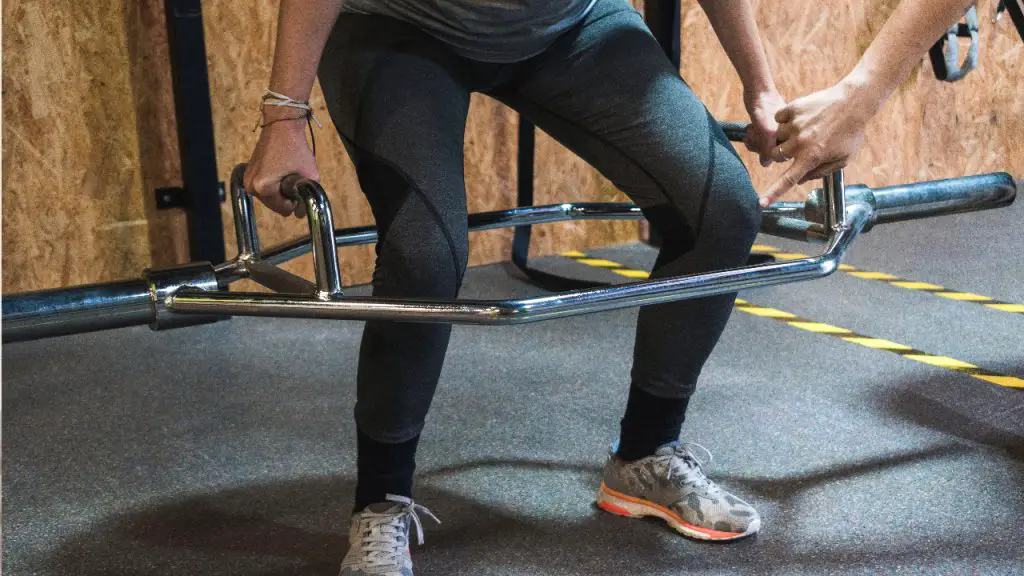Should I Use a Hex Bar for Deadlifts? Essential Facts You Need to Know

ListedFit is reader-supported. When you buy through links on our site, we may earn a small commission.
Deciding whether to use a hex bar for deadlifts can be a challenging decision for fitness enthusiasts and athletes alike.
Hex bars, also known as trap bars, have gained popularity for their potential ergonomic advantages over conventional barbell deadlifts.
This alternative lifting bar allows for a more natural lifting position, potentially reducing the risk of injury and making it an attractive option for deadlifters.

Quick Summary
While some fitness experts argue that hex bar deadlifts are a safer alternative, others contend that traditional barbell deadlifts offer superior muscle activation and athletic performance benefits.
Evaluating the advantages and disadvantages of both types of deadlifts will ultimately help you determine if the hex bar deadlift is right for your goals and current fitness level.
Key Takeaways
- Hex bars can offer a more ergonomic lifting position, potentially reducing the risk of injury.
- Conventional deadlifts may provide superior muscle activation and athletic performance benefits.
- Evaluating the pros and cons of hex bar and barbell deadlifts will help you make an informed decision based on your fitness goals.
Table of Contents
How to Perform a Hex Bar Deadlift
Performing a hex bar deadlift is an excellent way to improve your overall strength and muscle development. Follow these simple steps to do the exercise correctly:
- Load the hex bar: Firstly, add your desired weight to the hex bar, making sure that you put barbell collars on the end of the barbell. This will prevent the plates from sliding off if you’re slightly imbalanced.
- Stand in the hex bar: Position yourself inside the hex bar with your feet hip-width apart. Make sure you’re centred and your weight is evenly distributed.
- Grip the handles: Choose either the high or the low handles, depending on your preference, mobility, and comfort. Ensure your grip is secure and slightly wider than your knees.
- Set your stance: Bend your knees and lower your hips while maintaining a neutral spine. Your chest should be up and your shoulders should be directly above the handles. Keep your core tight and your back straight at all times.
- Lift the weight: Push through your heels and engage your glutes, driving your hips forward as you lift the hex bar off the ground. Keep your arms straight, and don’t forget to exhale as you stand up.
- Lower the hex bar: After reaching the top of the movement, slowly lower the hex bar back to the ground, maintaining a tight core and neutral spine. Remember to inhale as you begin returning the hex bar to the starting position.
Don’t forget to warm up properly and start with a lighter weight before gradually progressing. This will help you minimise the risk of injury and make your hex bar deadlift experience more enjoyable.
Comparing Hex Bar Deadlifts With Other Deadlift Variations
So, you’re considering the hex bar for deadlifts, and you want to know how it stacks up against other deadlift variations, right? Let’s dive into some comparisons and see how the hex bar deadlift, also known as the trap bar deadlift, differs from its barbell counterparts, mainly the conventional and sumo deadlifts.
Firstly, let’s have a look at the hex bar itself. This bar is shaped like a hexagon, allowing you to stand in the middle while performing the lift. It tends to be more accessible and can offer a user-friendly alternative to the standard barbell.
The traditional barbell deadlift, on the other hand, is performed using a standard or Olympic barbell. This classic lift engages your posterior chain muscles – think upper and lower back, glutes, hamstrings, and calves – and is a staple in many athletes’ strength training routines, including powerlifters and bodybuilders.
Now, let’s quickly chat about sumo deadlifts. In this variation, you take a wider stance and grip the bar between your legs. This adjustment leads to a more upright torso position and shorter range of motion, potentially reducing stress on the lower back.
When comparing these deadlift variations, the hex bar deadlift sits somewhere between the conventional and sumo movements. Due to its design, the hex bar allows a more neutral grip and places the weight closer to your centre of gravity, which can help reduce strain on the lower back. This comes in handy if you’re struggling with barbell deadlifts due to discomfort or mobility issues.

While all three deadlift styles serve to build strength and power, the hex bar deadlift has been shown to produce higher peak force, power, and velocity in certain studies. This might make it a popular choice for athletes looking to improve their explosiveness or jump performance.
That being said, the conventional and sumo deadlifts still hold their ground when it comes to targeting specific muscle groups. The conventional deadlift places more emphasis on the posterior muscles while the sumo deadlift shifts more workload to the quadriceps. So, if you’re looking to fine-tune a particular aspect of your strength, you might find that sticking to these barbell variations is the way to go.
The choice between a hex bar, traditional barbell, or sumo deadlift comes down to your goals, preferences, and individual anatomy. It’s always wise to give each a try to see which one feels the most comfortable and efficient for you. Happy lifting!
Pros and Cons of Using Hex Bar for Deadlifts
When it comes to deadlifts, there’s a debate between using a hex bar or a traditional straight barbell. Let’s explore the pros and cons of using a hex bar for deadlifts.
Pros:
- Easier on the lower back: The hex bar allows you to position your body within the frame, resulting in a more upright starting position. This can reduce the stress on your lower back when compared to a traditional barbell deadlift.
- Heavier lifts: Many people find they can lift more weight using a hex bar. This is possibly due to the more central distribution of the load and improved engagement of the quadriceps and hips.
- Better grip and comfort: The hexagonal frame provides comfortable, ergonomic grip options that can be easier on the wrists and elbows compared to a straight bar.
Cons:
- Less specificity: If you’re a powerlifter or competing in a sport where the traditional barbell deadlift is specifically required, using a hex bar might not be the best option. Hex bar deadlifts place more emphasis on your legs and a bit less on your posterior chain, which may lead to a disparity in muscle development and strength.
- Limited availability: Not every gym will have a hex bar available. If you become reliant on it for your deadlifts and need to switch gyms or workout elsewhere, you might find it harder to adjust back to a traditional barbell.
- Less transferable skills: Since hex bar deadlifts differ mechanically from traditional barbell deadlifts, the skills you develop may not translate as effectively to other barbell exercises like bent-over rows, cleans, or snatches.
The hex bar can be an excellent option for deadlifts, especially if you want to focus on lifting heavier weights and prioritise comfort. However, if you’re training for powerlifting or require specific strength in certain muscle groups, the traditional barbell deadlift might be a better option.
Is Trap Bar Deadlift Better for Athletes?
When it comes to deadlifts, you might be wondering if using a trap bar (also known as a hex bar) is a better option for you as an athlete. Let’s discuss the advantages of trap bar deadlifts and how they can benefit your training regimen.

First off, trap bar deadlifts are known for placing less stress on your lower back compared to traditional barbell deadlifts. This is primarily due to the design of the trap bar that allows you to stand inside it, leading to a more upright posture while performing the lift. As a result, you can potentially avoid excessive strain on your spine and lower the risk of injury, which is crucial for keeping your training consistent and injury-free.
“Another advantage of trap bar deadlifts is their ability to help you lift heavier loads.”
The unique design of the hex bar allows for more even weight distribution, making it easier to maintain balance and control during the lift. This means you could potentially push yourself to lift heavier weights, resulting in increased muscle mass and strength gains over time.
It’s also worth mentioning that the trap bar deadlift engages different muscle groups compared to the barbell deadlift.
While the traditional barbell deadlift focuses on strengthening the erector spinae and hip muscles, the trap bar deadlift engages your quadriceps to a greater extent, making it more similar to a squat. This can help you develop a more balanced and powerful lower body, essential in athletic performance.
Incorporating trap bar deadlifts into your training routine could prove to be beneficial for you as an athlete. By reducing stress on the lower back, allowing you to lift heavier loads, and promoting more balanced muscle development, the trap bar deadlift can be a valuable addition to your strength and conditioning program.

Is Hex Bar Deadlift Safer?
As you explore ways to improve your deadlifts, you might come across the hex bar as an alternative to the traditional straight barbell. One of the main concerns is whether the hex bar deadlift is actually safer than the conventional deadlift.
Thanks to the unique design of the hexagonal barbell, some lifters find it beneficial as it can potentially reduce strain on the lower back. The hex bar allows you to stand inside the bar rather than behind it, which can help maintain a more upright posture during the lift. This positioning may alleviate some of the pressure on your lower back and allow for safer lifting, especially if you have pre-existing back issues or concerns.
However, it’s crucial to remember that the level of safety for hex bar deadlifts, like any other exercise, depends on proper form and technique. You’ll need to ensure that your grip is parallel to the outside of your feet while standing inside the hex bar. Additionally, just like with any other exercise, gradually increasing weight and maintaining control throughout the entire movement can contribute to a safer deadlift experience.
The hex bar deadlift might offer some advantages in terms of safety, particularly when it comes to lower back strain. It’s important, however, to still focus on your form, technique, and progressive weight increases to ensure the best possible outcome for your lifting journey.

Conclusion
So, you’re considering whether to use a hex bar for deadlifts. Here’s the bottom line: the hex bar deadlift is a great exercise for both novices and pros. It targets multiple muscle groups, including your quadriceps, hamstrings, glutes, and back muscles. This makes it a highly effective way to build overall strength and power in your lower body.
One key advantage of the hex bar is that it allows you to lift heavier weights. This can lead to increased muscle growth and strength gains. In a hex bar deadlift, you stand with the grip parallel to the outside of your feet, as opposed to a barbell deadlift where the bar is in front of you.
A hex bar can be a valuable addition to your workout routine, and it might just be the tool you need to elevate your deadlifting game. The unique design gives you a slightly different experience and can help break through plateaus or switch up your strength training. Ultimately, it’s up to you to decide what feels best for you and your goals.
Remember that both hex bar and barbell deadlifts have their place in training, and it’s important to select the right tool for the job. Try incorporating hex bar deadlifts into your routine, and see the difference it can make to your lifting performance. Happy lifting!
Frequently Asked Questions
What are the benefits of using a hex bar?
Using a hex bar for deadlifts provides several advantages compared to a traditional straight barbell.
One key benefit is the reduced strain on your lower back, as your centre of gravity is closer to your body.
This makes it a great option for those with lower back issues or beginners just starting out with deadlifting.
Additionally, hex bars are often easier to learn because they require less hip and ankle mobility compared to a straight barbell deadlift.
Are there drawbacks to hex bar deadlifts?
While hex bar deadlifts provide some benefits, there can be drawbacks as well. One possible disadvantage is reduced development of your posterior chain muscles, which include the hamstrings, glutes, and lower back muscles.
This is because the hex bar tends to shift more emphasis towards your quadriceps. Also, hex bars are a specialised piece of equipment, and not all gyms may have one available for use.
How does hex bar deadlift form differ from barbell deadlift?
The primary difference between hex bar deadlift and barbell deadlift form is the positioning of your body and the bar.
With a hex bar, you step inside the bar, allowing you to lift the weight around you, which leads to a more upright torso position. In a barbell deadlift, you stand behind the bar and bend over to grip it, which requires more hip and lower back mobility.
How much weight should I use for hex bar deadlifts?
The ideal weight for hex bar deadlifts will vary depending on your experience, strength, and goals. As a beginner, it’s wise to start with a lighter weight and focus on developing proper form.
Gradually increase the weight as your strength and technique improve. It’s always a good idea to consult a certified personal trainer or coach for guidance on selecting the appropriate weight for your needs.
Is using a hex bar considered cheating?
No, using a hex bar for deadlifts is not considered cheating. While the hex bar may make the lift mechanically easier, it’s still a valid and effective strength training exercise.
Remember that different variations of an exercise can target different muscle groups and provide unique benefits. It’s best to include a range of exercises in your training programme to ensure balanced development.
Are hex bar deadlifts safer than barbell deadlifts?
Hex bar deadlifts can be considered safer than barbell deadlifts, particularly for individuals with lower back issues or beginners.
By allowing for a more upright torso position, hex bar deadlifts place less stress on the spine and lower back. However, it’s important to maintain proper form and use an appropriate weight to minimise the risk of injury in any type of deadlift.
Author
- Danny Loeb is a qualified Personal Trainer, Fitness Model and Writer. He enjoys blogging about health and fitness, messing around with Photoshop, and sharing his experiences with everyone.
Latest entries
 NutritionFebruary 6, 2024What Are Fillers in Supplements? – Unveiling Inactive Ingredients
NutritionFebruary 6, 2024What Are Fillers in Supplements? – Unveiling Inactive Ingredients FitnessAugust 23, 2023Best Post-Workout Foods: Great Ideas for Recovery and Results
FitnessAugust 23, 2023Best Post-Workout Foods: Great Ideas for Recovery and Results BulkingJuly 26, 2023Is Rice Good for Bulking? Unveiling the Truth
BulkingJuly 26, 2023Is Rice Good for Bulking? Unveiling the Truth CultureJuly 15, 2023Why Do People Hate Planet Fitness? Read This Before You Join!
CultureJuly 15, 2023Why Do People Hate Planet Fitness? Read This Before You Join!
Affiliates:
This post may contain affiliate links that at no additional cost to you, the site may earn a small commission. We only recommend products we would use ourselves and all opinions expressed on this site are our own.
General Advice:
The information provided in this article is for general informational purposes only. It is not intended as a substitute for professional advice. Always consult with a qualified healthcare professional before starting any new diet, exercise program, or making changes to your health routine.
Accuracy Advice:
While we strive to provide up-to-date and accurate information, the content in this article may not reflect the most current research or medical guidelines. We encourage readers to do further research and consult with professionals for more personalized advice.
Our Recommendations:
The products and services mentioned in any of our articles are recommended based on our independent research and personal experience. We are not sponsored by any company. We aim to suggest products and services we believe are of high quality and could be beneficial to our readers.






